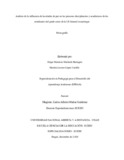Mostrar el registro sencillo del ítem
Análisis de la influencia de la cátedra de paz en los procesos disciplinarios y académicos de los estudiantes del grado sexto de la I.E General Anzoátegui
| dc.contributor.advisor | Muñoz, Carlos | |
| dc.coverage.spatial | cead_-_ibagué | |
| dc.creator | Machado Barragán, Edgar Mauricio | |
| dc.creator | López Castillo, Maritza Leonor | |
| dc.date.accessioned | 2020-12-29T16:24:29Z | |
| dc.date.available | 2020-12-29T16:24:29Z | |
| dc.date.created | 2020-11-18 | |
| dc.identifier.uri | https://repository.unad.edu.co/handle/10596/38677 | |
| dc.description.abstract | La cátedra de paz surge como preocupación por parte del gobierno nacional en 2013 por las reiteradas formas de violencia en los centros escolares, es por ello que durante el gobierno del entonces presidente Juan Manuel Santos, en el marco de la negociación de un conflicto armado de más de 50 años, entre los acuerdos pactados con la guerrilla de las FARC-Ep, se estableció que era necesario implementar desde los centros escolares de todo Colombia una pedagogía en búsqueda de la resolución pacífica de conflictos, es así como la cátedra de paz nace como ley en el año 2014 , para ser orientada en las escuelas y colegios del país. Para Castillo Prieto y Méndez Castiblanco , desde que se firmaron los acuerdos de paz con la organización insurgente FARC-EP, desde distintas entidades se empezó a abordar el tema de la paz como cultura a promover, no solo desde la esfera política sino desde lo educativo. En este contexto nuestro trabajo se inscribe en la línea de investigación educación y desarrollo humano por qué desde la educación se busca implementar la cátedra de paz por la capacidad transformadora que tiene la educación, además en la cátedra de paz se tienen en cuenta temas transversales como el pensamiento crítico, los derechos humanos respeto por las diferencias y desarrollo sostenible, es decir el respeto por la naturaleza y el buen uso de sus recursos, por tanto el núcleo problémico de esta investigación es pedagogía para el desarrollo humano y sostenible. Pero con la ley cátedra queda un interrogante y un vacío teórico práctico en las instituciones educativas, quienes en primera medida no saben qué hacer al no contar con docentes y directivos formados para llevar la experiencia de la cátedra de paz a las aulas, ese fue el primer obstáculo que tuvo la cátedra de paz, el segundo fue la no implementación debido al desconocimiento y falta de preparación temática, el tercer obstáculos fue la implementación de modo meramente teórico, sin que se articulara con actividades prácticas que abordarán los problemas reales de la instituciones educativas, por lo cual se convirtió en una asignatura más, sin resultados prácticos y sin alcanzar ni de cerca los fines para los cuales fue creada. Pese a lo anterior, también hay numerosos ejemplos donde instituciones educativas, adaptan patrones de educación para la paz al contexto específico en el que se encuentran, logrando una mayor aceptación de la comunidad educativa. | |
| dc.format | ||
| dc.title | Análisis de la influencia de la cátedra de paz en los procesos disciplinarios y académicos de los estudiantes del grado sexto de la I.E General Anzoátegui | |
| dc.type | Monografia | |
| dc.subject.keywords | Cátedra de paz | |
| dc.subject.keywords | Competencias socioemocionales | |
| dc.subject.keywords | Construcción de ciudadanía | |
| dc.subject.keywords | Derechos humanos | |
| dc.subject.keywords | Paz | |
| dc.subject.keywords | Resolución de conflictos | |
| dc.description.abstractenglish | The chair of peace emerged as a concern on the part of the national government in 2013 due to the repeated forms of violence in schools, that is why during the government of then-president Juan Manuel Santos, in the framework of the negotiation of an armed conflict in More than 50 years, between the agreements reached with the FARC-Ep guerrillas, it was established that it was necessary to implement from schools throughout Colombia a pedagogy in search of the peaceful resolution of conflicts, this is how the chair of peace was born as law in 2014, to be oriented in the schools and colleges of the country. For Castillo Prieto and Méndez Castiblanco, since the peace agreements were signed with the insurgent organization FARC-EP, different entities began to address the issue of peace as a culture to promote, not only from the political sphere but from the educational sphere . In this context, our work is part of the education and human development research line, because education seeks to implement the chair of peace due to the transformative capacity that education has, in addition, in the chair of peace, cross-cutting issues such as critical thinking, human rights, respect for differences and sustainable development, that is, respect for nature and the proper use of its resources, therefore the problem nucleus of this research is pedagogy for human and sustainable development. But with the chair law there is a question and a practical theoretical void in educational institutions, who in the first measure do not know what to do because they do not have teachers and managers trained to bring the experience of the chair of peace to the classrooms, that was the The first obstacle faced by the chair of peace, the second was non-implementation due to ignorance and lack of thematic preparation, the third obstacle was implementation in a merely theoretical way, without articulating it with practical activities that will address the real problems of the institutions educational, for which it became one more subject, without practical results and without reaching even close to the purposes for which it was created. Despite the above, there are also numerous examples where educational institutions adapt patterns of education for peace to the specific context in which they are found, achieving greater acceptance by the educational community. | |
| dc.subject.category | Ciencias sociales | |
| dc.subject.category | Educación | |
| dc.subject.category | Cátedra de paz | |
| dc.subject.category | Cultura |















